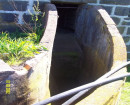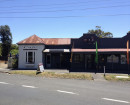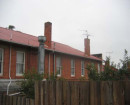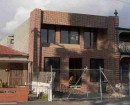Marathon
7 Gray Street HAMILTON, Southern Grampians Shire
Church Hill Precinct Hamilton
-
Add to tour
You must log in to do that.
-
Share
-
Shortlist place
You must log in to do that.
- Download report


Statement of Significance
STATEMENT OF SIGNIFICANCE
Marathon
7 Gray Street
This house has local significance especially for its historical associations with a number of important early Hamiltonians including Thomas Ross, schoolteacher, Richard Heath (c1815-1895), publican, in the 1870s; and the auctioneers George Dilnot (1852-1892) in the late 1880s, and John Stewart (1868-1944) in the 1900s. The earliest portion of the building may date from 1866 or earlier when Ross owned and occupied a small house on the site. ([i]) During Richard Heath's owner/occupancy from 1877 to c1885, the brick house had additions which may have doubled its size. ([ii]) Heath, who managed Hamilton's first hotel, the Grange Inn, from 1854-1864 was one of the first municipal councillors in 1859. ([iii]) Dilnot, who became the new owner in the late 1880s, floated a Western City Brewing Co. and managed it until his death, and also in 1888 he floated the Victoria Bee Co., which established an apiary at Dunkeld. ([iv]) John Stewart, as well as being a local auctioneer and property owner, was Mayor of Hamilton from 1901-1914. ([v])
The final style of the house can be described as Italianate, the most common for domestic buildings during this period and this is a typical and sober example. Little now survives of the original garden however the Brachychiton acerifloius, Illawarra Flame tree in front of the house indicates an early garden form.
[i] Hamilton Rate Book 1866, No. 272 (NAV 12 pounds), 1869, No. 274 (NAV 24 pounds).
[ii] Ibid., 1878, No. 300 (brick house, additions in progress, NAV 45 pounds).
[iii] Garden, Don, Hamilton, pp 41, 68, 83.
[iv] Ibid., p 132.
[v] Ibid., pp 130, 162, 173.
-
-
Marathon - Physical Description 1
Roof: »corrugated iron
Walls: »cement rendered brick
Dressings: »cement render
Plinth: »bluestone
Windows: »timber double hung sash
Paving: »gravel path
Other:»verandah floor unglazed terra cotta tilesNOTABLE FEATURES:»non-matching gables
Marathon - Integrity
INTEGRITY: E
CONDITION: GMarathon - Historical Australian Themes
Evolution of the Town: 1860s, 1870s, 1880s, 1900s.
Notable men and women:
Secondary Industry: Breweries
Tertiary Industry: Hotels Auctioneers
Education:
Local Government:Heritage Study and Grading
Southern Grampians - City of Hamilton Conservation Study
Author: Timothy Hubbard with Carlotta Kellaway & Michael Looker (plus Francis Punch)
Year: 1991
Grading: C
-
-
-
-
-
MECHANICS INSTITUTE
 Victorian Heritage Register H2171
Victorian Heritage Register H2171 -
HAMILTON BOTANIC GARDENS
 Victorian Heritage Register H2185
Victorian Heritage Register H2185 -
HAMILTON GAS HOLDER
 Victorian Heritage Register H1086
Victorian Heritage Register H1086
-
"1890"
 Yarra City
Yarra City -
"AMF Officers" Shed
 Moorabool Shire
Moorabool Shire -
"AQUA PROFONDA" SIGN, FITZROY POOL
 Victorian Heritage Register H1687
Victorian Heritage Register H1687
-
'The Pines' Scout Camp
 Hobsons Bay City
Hobsons Bay City -
106 Nicholson Street
 Yarra City
Yarra City -
12 Gore Street
 Yarra City
Yarra City
-
-















